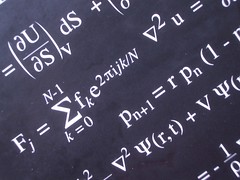 |
In a preprint Double-graded quantum superplane, Steven Duplij and I construct a “higher” graded version of Manin’s quantum superplane. To our knowledge, this is the first quantum space that has an underlying \(\mathbb{Z}_2^2\)-grading. |
Outline
The hunt was on to find a direct generalisation of Manin’s superplane [1] to the setting of \(\mathbb{Z}_2^2\)-geometry [2]. We found such a generalisation by using a single deformation parameter and treating the two coordinates of degree (0,1) and (1,0) equally. The general structure was motivated by Manin’s quantum superplane and any choices were made so that our quantum space closely resembles two copies of the quantum superplane. However, as we use a rather novel grading, there are some subtle sign differences. Some of these we highlight in the preprint.
Quantum or noncommutative spaces?
At some level it is expected that space-time itself will change drastically from its classical smooth manifold structure – you cannot zoom in forever and still see a nice smooth structure. By arguments based on quantum mechanics, space-time at the smallest scales should be granular or noncommutative in nature. In standard mathematics, say for two ordinary numbers, ab = ba. However, when we enter the world of quantum mechanics we are forced to consider situations where the objects no longer commute, i.e., ab and ba are different. Noncommutative geometry is, roughly, the study of geometries where the coordinates no longer necessarily commute. In practice, one has to take a very algebraic approach to geometry and this allows for some very strange things. But I stress, physics seems to demand that we think about such weird geometry.
The double-graded quantum superplane
The double-graded quantum superplane, as we defined it, has coordinates \((x, \xi, \theta, z)\) of degree (0,0), (0,1), (1,0) and (1,1), respectively. These degrees will determine some sign factors in various constructions. The algebra of polynomials on this quantum space are polynomials in the above coordinates subject to the relations:
\(x\xi − q \,\xi x = 0\),
\(x\theta − q \,\theta x = 0\),
\(xz − z x = 0\),
\(\xi^2 = \theta^2 =0\),
\(\xi \theta – \theta \xi =0\),
\(\xi z + q^{-1} \, z \xi =0\),
\(\theta z + q^{-1} \, z \theta =0\).
Here \(q\) is a non-zero complex number assumed not to be a root of unity.
The above relations are not “super” in origin. Notice that the fermionic coordinates \(\xi\) and \(\theta\) mutually commute, the are “relative bosons”. Furthermore, \(z\) is bosonic, yet it satisfies a fermionic commutation rule with \(\xi\) and \(\theta\), we have “relative fermions”. Roughly, we have two copies of the quantum superplane for which the fermionic coordinates across the two copies commute and then a rather strange extra bosonic coordinate that is fermionic with respect to the fermionic coordinates. The reader should immediately be reminded of parastatistics [3,4], though this itself was not motivation for the work.
Differential calculi
In the preprint, we explicitly show how to construct a bi-covariant differential calculi on the double-graded quantum superplane in the sense of Woronowicz [5]. That is, we understand how to do differential calculus on this quantum space. We deduce all the commutation rules between the coordinates, differentials and partial derivatives. The interested reader should consult the original work for details.
Closing remarks
Noncommutative geometry is somewhat “work in progress” and should encompass classical geometry while giving us deep insight into the very nature of the fabric of our Universe. Thus, it is important to explore various examples of noncommutative spaces to gain further insight into what one could really mean by a “noncommutative geometry” and how it can be applied to physics. In our preprint we give a simple but rather novel example of a noncommutative space and one that is well-motivated by recent developments in “higher graded supermanifolds”, a topic I have also been at the forefront of developing.
References
[1] Yu.I. Manin, Multiparametric quantum deformation of the general linear supergroup, Commun.Math.Phys. 123 (1989) 163-175
[2] T. Covolo, J. Grabowski, and N. Poncin, The category of \(\mathbb{Z}_2^n\) -supermanifolds, J. Math. Phys. 57 (2016), 073503, 16.
[3] H. S. Green, A generalized method of field quantization, Phys. Rev. 90 (1953), 270–273.
[4] D. V. Volkov, On the quantization of half-integer spin fields, Soviet Physics. JETP 9 (1959), 1107–1111.
[5] S. L. Woronowicz, Differential calculus on compact matrix pseudogroups (quantum groups), Comm.
Math. Phys. 122 (1989), 125–170.